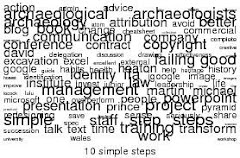The worst of the recession appears to be over, at least for archaeology. The concern now (for the remaining members of the profession) is whether it can cope with a rise in demand for work, needing more staff, and in particular if the lack of specific skills will prevent or delay projects. I don't think it should.
There may be a pool of archaeologists, laid off in summer 2008, who would be available for recruitment. This may prove harder than expected; it is surprising how quickly people realise that archaeology may not in fact be the only way they want to spend their lives. Quite apart from the fact that they can probably earn more for doing less demanding work, the basic level benefits may prove hard to resist - the prospect of long hours in the van to be dropped in on some random site may appeal less to people who've got used to being paid from the moment they walk into the office.
But even so, that leaves a smallish gap. Even if the 600 or so posts which were lost were re-created, there have been 8,000 new graduates in archaeological subjects since September 2008 (based on the figures in Profiling the Profession). Doing some analysis of the figures for age profile and length of contract, there were 1,000 archaeologists in the age range 25-29 who responded, representing a cohort of about 600/year. (It's a shame that the websites advising would-be archaeologists on degree courses don't point out that 1 in 10 of graduates in normal conditions end up working in the profession.) So any shortfall in available existing diggers could be readily filled by new staff.
Of course, for many years now archaeologists have been unwilling to employ such people, leading to the dilemma that only those with experience will be employed. This makes life easier, since even new staff will be able to work from the start, but obscures the fact that someone somewhere must have provided some training. You hope so, anyway, although the fact that someone has been on lots of sites may not mean they have contributed much or learnt anything. Rather than rely on this informal apprenticeship, an employer would be better served by audited the skills of its new staff, identifying any gaps, and maybe, you know, provide some training. This need not be a series of lectures on the theory of stratigraphy - it could consist of being shown common local pottery types, or how to start a sludge pump.
Although it is hard to extract this directly from the report, it appears that most of these recent graduates working on commercial fieldwork projects up to the age of 29 then move on, either to other roles within archaeology, or leaving the profession. As a result, employers should expect that there will be turnover, so there will be new recruits, so there will be training needs. So plan for them.
But the other side of the concern is the loss of specific specialist skills, such as building survey. How can an organisation deliver a project without the necessary trained specialist staff? The answer is, the same way they used to, before 41% of staff had masters degrees, before Investors in People, before CPD. If you need someone to record a building, send them out with some drawing stuff and cameras, and tell them to get on with it. Archaeologists used to be good at devising, developing, and refining methodologies for new areas of work - so as soon as the Hedgerow Regulations 1997 defined the need to determine which hedgerows are historic, projects came in and were done. And desk-based assessments as a formal exercise were created overnight by PPG16- and again, they were done. Not perfectly. But archaeologists are capable flexible people with a strong grasp of recording and reporting. It may be that some silly errors are made, that buildings are misclassified or misunderstood. But a record will be made: possibly a different record, possibly a better record, than one that would have been made by a buildings expert with tunnel vision for a specific feature or type of building. It is interesting to note that East Lothian Council assumed that it would be archaeologists who would be dealing with recording buildings (see their excellent Historic Building Recording guidance (2006)), a view that would have been anathema to Conservation Officers in the 1990s who thought architectural historians should be relied upon.
And finally, it must be said that a break in continuity, and a return to first principles, might be a good thing. Commercial archaeology before the bubble burst had become a frantic, mechanical process yielding isolated factoids. OASIS now has 4000 grey literature reports for download. A random example is Wessex Arcaheology's report on The Wickets (the report is clear and detailed) (also available direct from Wessex). A planning condition, a written scheme of investigation, a specification, an evaluation, a report, an archive, to commemorate the fact that trenches were dug and nothing was found. Perhaps it was worthwhile. But for the planners to require developers to fund the excavation of 6% of the site area on the basis of: residual flints found in the general area (but not the site), residual Roman pottery and medieval found in the general area (but not the site), and the possibility that medieval tenement plots might run back 100m from the High Street (although there are no topographic grounds for expecting they might, or that they would yield significant archaeological remains if they did), seems bizarre. The report describing this evaluation says "No archaeological research, either desk based or intrusive has previously been
undertaken for this Site." Perhaps some map work might have been a simpler and better way to decide on the burgage plot question? Surely this 'dig a hole just in case' mentality should be rethought? How about assessing on some real basis the likelihood that archaeological remains might be affected before swinging into overkill mode?
(I should note that I have no particular issue about or knowledge of this development and its archaeology, but it does seem an exemplar of everbody working very hard to prove that nothing was there, when there seemed few grounds for thinking there would be).
Tuesday 29 September 2009
Bridging the skills gap and re-thinking evaluation practice
Posted by
Martin Locock
at
22:51
0
comments
![]()
Labels: evaluation, history, identity, training
Subscribe to:
Posts (Atom)






